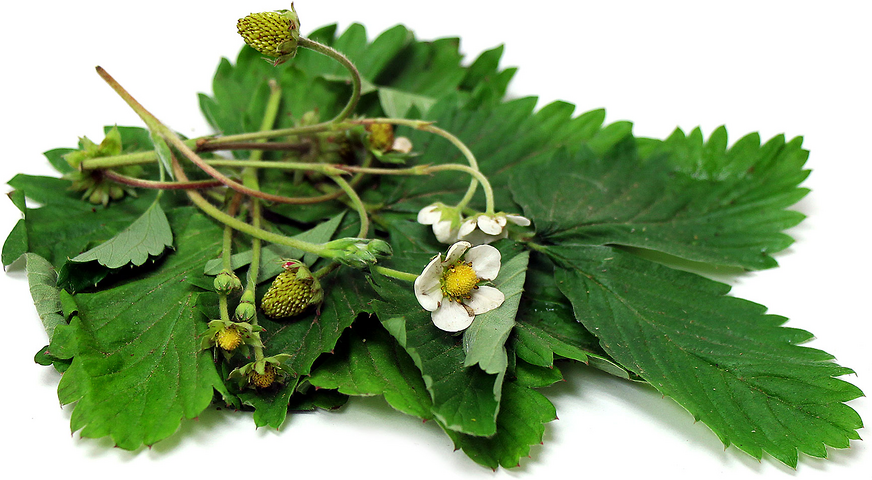


Strawberry Leaves
Estimated Inventory, oz : 0
Description/Taste
Wild strawberry leaves are small to medium in size and are flat and oblong in shape, averaging 4-5 centimeters in width. The dark green leaves are matte, have silky hairs on the underside, and have toothed or serrated edges. The leaves grow in groups of three on hairy stems that can reach up to 10-15 centimeters in height. Wild strawberry leaves grow on a trailing plant that spreads out low to the ground on horizontal runners which turn into roots to create new plants. The plants are also identified by their small white flowers and red fruits. Wild strawberry leaves have a mild, fruity flavor with fresh grassy, herbal notes and a mildly astringent finish.
Seasons/Availability
Wild strawberry leaves are available in the spring through summer.
Current Facts
Wild strawberry leaves, botanically classified as Fragaria vesca, grow on a perennial plant that can reach up to twenty centimeters in height and are members of the Rosaceae, or rose family. Wild strawberry plants are often found growing along sidewalks, fields, and edges of wooded areas. There are over twenty different species of strawberries, and all parts of the plant including the leaves, fruit, and stem can be used medicinally. Wild strawberry leaves are often overshadowed by the bright red fruit. Strawberry leaves are highly nutritious and are an important ingredient in natural medicines and cosmetics.
Nutritional Value
Wild strawberry leaves are an excellent source of iron, antioxidants, vitamin C, K, and a polyphenolic compound called tannin. They also contain ellagic acid which has immune-boosting properties.
Applications
Wild strawberry leaves can be consumed in both raw and cooked applications such as boiling. Some consider the leaves to taste unpleasant if eaten raw, but others use the fresh leaves in salads. Wild strawberry leaves are most popularly consumed as a tea from either fresh or dried leaves. After steeping for five minutes, the tea may be enjoyed as a caffeine-free beverage or as a tonic to treat digestive ailments and reduce inflammation. The tea can also be combined with brown sugar to create a syrup that adds a clean herbal note to strawberry desserts or a sweet element to salad dressings. Wild strawberry leaves pair well with many of the same flavors as its fruit including almond, mascarpone, sour cream, raspberry, melon, orange, vanilla, and balsamic vinegar. Wild strawberry leaves should either be used immediately fresh or dried for later use. It is not recommended to store and use when slightly wilted.
Ethnic/Cultural Info
The Blackfoot, Cherokee, Ojibwa and Iroquois Tribes in North America used Wild strawberry leaves as a disinfectant and a treatment for gastrointestinal problems. The plant as a whole is considered an antiseptic due to large amounts of tannins, and the leaves were often boiled and consumed to help purify the blood. The tribes would also chew, dry, or mix the crushed leaves with other ingredients to apply to sores and burns. In addition to the leaves, the fruit was also used for a health booster, and the aroma of the plant was used to draw in wildlife for hunting.
Geography/History
Wild strawberries are native to North America and have been growing since ancient times. Today Wild strawberry plants can be found in Europe, North America, Asia, and Australia and the leaves can be found in the wild or at select fresh markets.
Recipe Ideas
Recipes that include Strawberry Leaves. One
| Outdoor Adventures |
|
Strawberry Leaf Tea |
| Cabinorganic |
|
Wild Strawberry Leaf Tea |
| Mother Earth Living |
|
Homemade Strawberry Tea |




